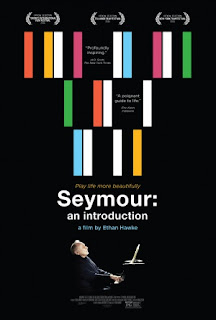Directed by: Ethan Hawke.
Featuring: Seymour Bernstein.
Occasionally,
you see a documentary about one of those rare people who seem completely at
ease with themselves – completely content, who have lived the life they want to
live. Bill Cunningham’s New York a few years ago was like that – as it followed
the famed New York Times Fashion Photographer on his various journeys, all of
which seem to bring him joy. Albert Maysles’ Iris was also like that – as the
New York Fashion Icon simply goes about her life, and if people don’t like her,
she doesn’t much seem to care. Ethan Hawke’s Seymour: An Introduction is
another such example. Seymour Bernstein is a gifted pianist, who used to make
his living performing and composing, but at the age of 50, he decided to stop –
the performing at least – and in the decades since, he has become a teacher –
teaching the next generation how to play the piano, but also how to simply love
music. Bernstein has a lot of ideas about life – and music – and he isn’t shy
about telling anyone about them. He is also one of those people who seem
completely at peace with himself – completely content.
The
film is directed by Ethan Hawke, who makes clear in one of his few onscreen appearances
in the movie why he is making this documentary about Bernstein – Hawke has
questioned his own art, and its authenticity, and he sees Bernstein as someone
who has that authenticity that he seeks. Hawke allows Bernstein to hold court –
gives him the room to talk and talk about art, and how great art requires work
and patience – and how it reaches higher levels as a result. Hawke is clearly a
little bit in awe of Bernstein – which is why he allows him to speak
uninterrupted as much as he does. But I also think a part of Hawke is skeptical
of Bernstein as well – he lets much of what Bernstein says go unchallenged –
although I’m not sure Hawke fully agrees with him (and I certainly do not). In
a way though, it doesn’t really matter what Bernstein’s philosophy on music and
life really is – what matters is that he has one, and he sticks to it – that’s
a the message. To a certain extent, Seymour: An Introduction seems to take
place in a world that doesn’t exist much anymore (at least outside of a Woody
Allen movie) – of affluent New Yorkers sitting around and discussing art and
grand ideas. They may be somewhat out of touch – but that’s almost charming
here. Seymour is a throwback in almost every way.
When I watch a film like this, I cannot help but admire a character like Seymour Bernstein – a man who has dedicated his life to what he loves, and doesn’t really care for anything else. He has lived in the same, small apartment for 57 years – he has never married, doesn’t have any kids, and doesn’t seem to be interested too much in anything other than his art. To some, that probably sounds incredibly lonely and sad – and most people probably would not want to live the life that Seymour has. But it works for him – he’s happy, he’s content. He has ideas about art and life, and he lives by them – and tries to pass them along. The title of the movie alludes to a J.D. Salinger story, whose character much like Salinger himself, became a recluse. To some, I’m sure that is what Bernstein did as well after his retreat from the stage (one of the big hanging questions in the movie is why – it’s something I don’t think Hawke ever quite gets out of Bernstein – and the extended finale, in which Bernstein does in fact perform, for Hawke’s theater company and camera, is stunning) – but that’s not really the case with Bernstein. He’s not a recluse – he just wants to live the way he’s happy. You cannot argue with that.


No comments:
Post a Comment